Russian forces attack critical infrastructure in Sumy region
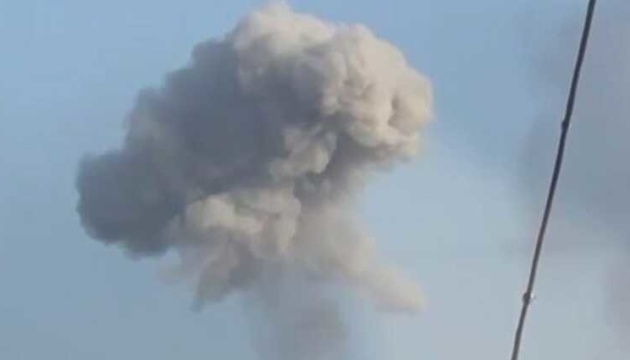

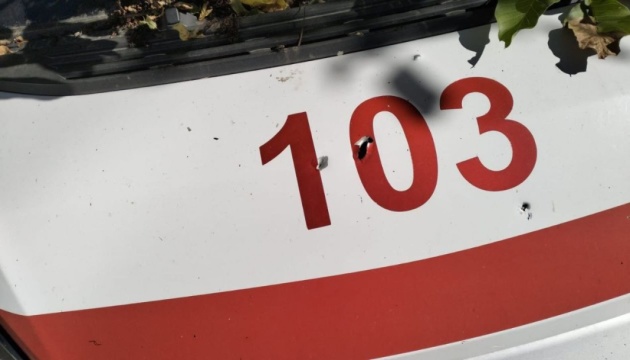
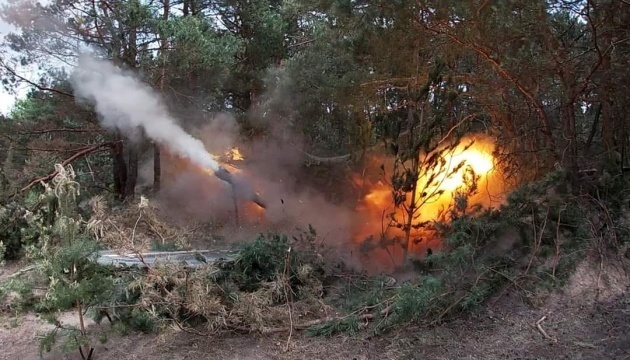
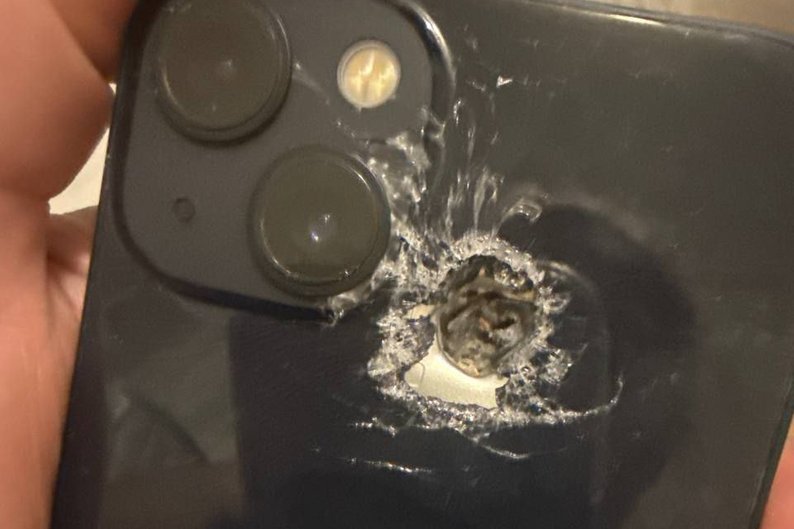
Ukraine endured another night of Russian drone attacks that left destruction in several oblasts. Civilian buildings, warehouses and public infrastructure were hit as waves of Shahed drones struck Kharkiv, Sumy, and Poltava.
In Kharkiv, residents spent another night under fire as explosions shook the city. Authorities confirmed that Russian forces attacked with ten Shahed-type drones. These drones struck the Kyivskyi district, where one hit a civilian enterprise that has not operated for years. Other strikes caused fires in a detached house in Kyivskyi district and in another building near the city. Mayor Ihor Terekhov later clarified that one of the attacks landed in a suburb rather than in Shevchenkivskyi district.
Emergency services reported that fires caused by the strikes were extinguished during the night. In Malodanilivska community, debris from drones set a 500 square meter production and storage building on fire. There were no injuries in Kharkiv during this latest wave.
In Sumy, Russian forces attacked several times on 26 July. The assault damaged the building of the Oblast Administration, a detached house across from it and a café. One of the strikes knocked out power to a local water supply facility. Later that evening, drones targeted the city again, striking the Kovpakivskyi district and wounding three civilians. According to Sumy Oblast head Oleg Hryhorov, all injured were hospitalized. Local police said a wounded 43‑year‑old man was in moderate condition.
On 27 July, Sumy came under another drone attack. This time, windows in homes and non-residential buildings were shattered, but there were no reported casualties.
Poltava oblast also faced damage from falling drone wreckage overnight on 27 July. Acting head of the Oblast Military Administration Volodymyr Kohut reported that debris from intercepted drones fell in Poltava and Kremenchuk districts. Four single-family homes and three farm buildings were damaged, but no one was injured.
Ukraine’s Air Force reported that Russia launched 83 drones, including Shahed and decoy types, from Russian territory and occupied Crimea starting at 22:30 on 26 July.
Air defenders used aviation, surface-to-air missile units, electronic warfare systems and mobile fire teams to repel the attack. By 10:30 on 27 July, air defenses had destroyed or suppressed 78 of the drones.
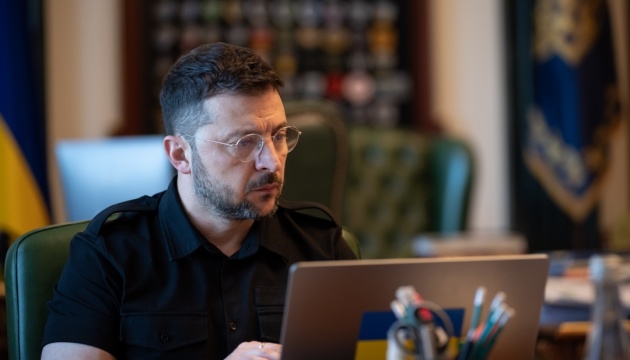

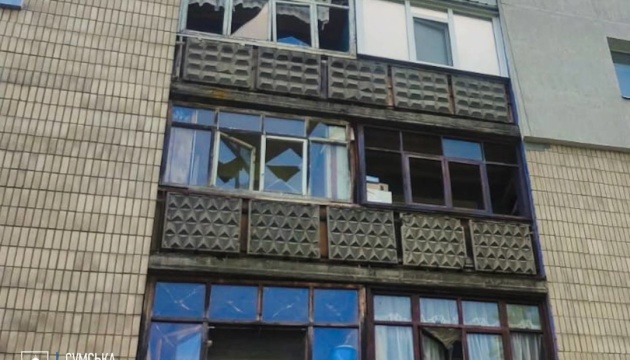

© Sputnik
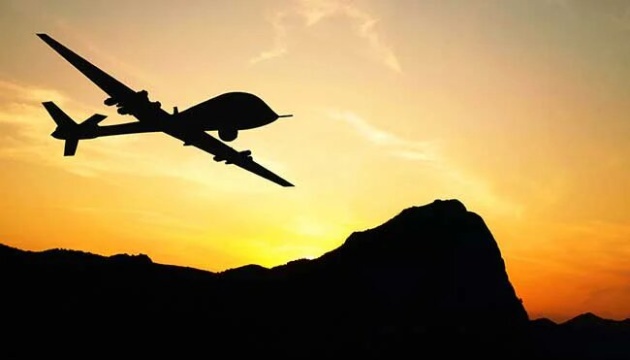

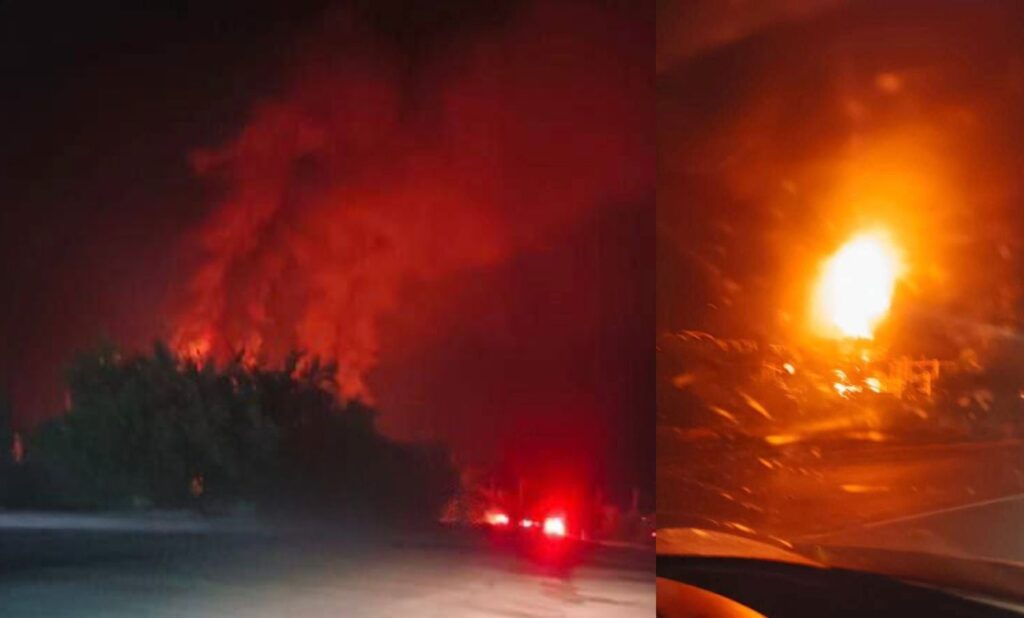
A railway power substation in Russia’s Volgograd Oblast burned after a night drone raid that caused explosions and a massive blaze near Zhutovo station. The strike cut electricity to rail lines, and forced flight restrictions across the area.
Explosions erupted in Volgograd Oblast overnight on 27 July, including near a railway electrical substation in Oktjabrskiy district. Russian authorities confirmed that drones attacked the facility and admitted that debris knocked out power in the railway’s contact network at Zhutovo station. Governor Andrei Bocharov said no one was injured during the strike.
The Russian Ministry of Defense claimed that air defenses allegedly shot down nine drones over the region. Despite these claims, Telegram channels published videos showing a large fire near the railway and a flash that appeared to be the moment of impact.
Ukrainian Telegram channel Exilenova+ reported that the substation supplies power to railway lines close to a fuel depot, and the fire started after the strike.
Exilenova+ also published photos showing damage to a building near the railways, and said that “also during the night, a technical building at Zhutovo station was attacked. Privolzhskaya Railway reported train delays due to falling UAV debris at Zhutovo station in Volgograd oblast.”
The attack led to a temporary shutdown of flights from Volgograd Airport. Restrictions remained in place from 00:40 to 07:30 local time as the damage was contained and power was restored to the rail network.
A similar drone strike took place on 21 July in Rostov oblast, hitting a rail station in Kamienolomni on 21 July and a railway substation in Novocherkassk on 23 July.
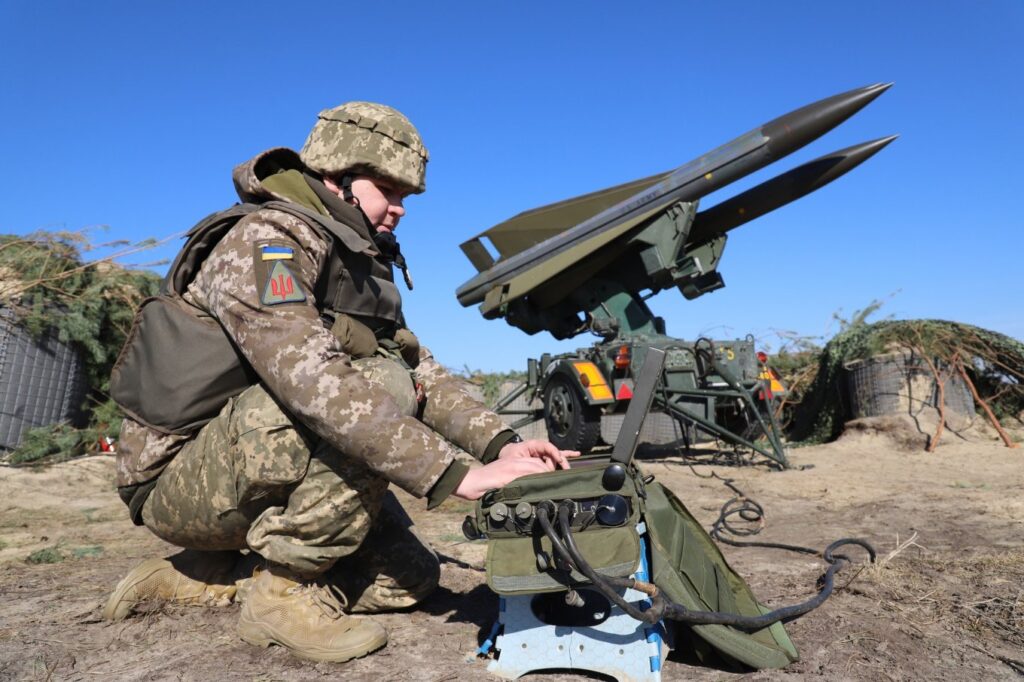
The Ukrainian government will spend $172 million buying vehicles, parts, training, maintenance and other services for the Ukrainian air force’s US-made Hawk air-defense batteries.
“This proposed sale will support the foreign policy goals and national security objectives of the United States by improving the ability of Ukraine to provide for its own defense,” the State Department noted.
The Hawk is becoming one of the most important air-defense weapons in Ukraine’s arsenal. Not because it’s particularly new: the Homing All the Way Killer missile dates from the late 1950s, making it a full generation older than Ukraine’s best air-defenses, its US-made Patriots.
No, the Hawk best attributes are its simplicity, reliability and—most importantly—abundance. A new facility in the US state of Oklahoma has been refurbishing thousands of the Hawk system’s 5-m missiles.
The Hawk is a medium-range surface-to-air missile. Each missile, fired by a three-round launcher, ranges around 48 km. The missile homes in on energy from a ground-based radar reflecting from the airborne target. The Ukrainian air force cited “experts” claiming the Hawk is 85% accurate, which is consistent with much newer missiles.
As a bonus, newer versions of the Hawk could be compatible with another, more modern missile system that Ukraine also uses: the US-Norwegian National Advanced Surface-to-Air Missile System, or NASAMS.
Norwegian firm Kongsberg—builder of the NASAMS—has developed a new digital command post for Hawk batteries that borrows its main components from NASAMS. That raises the possibility that the Ukrainian air force might, with some effort, be able to combine its NASAMS and Hawk batteries into a single force using the same radars and command posts.
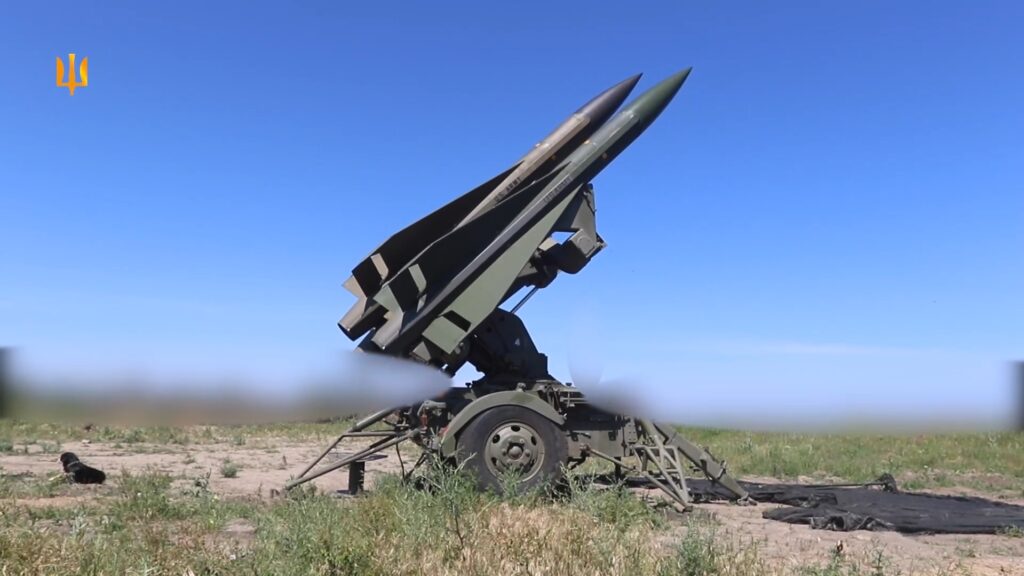
The Hawk was NATO’s standard medium-range SAM for decades until the advent—in the 1980s—of the Patriot, which ranges three times as far and boasts a much more sophisticated seeker. Raytheon manufactured many thousands of Hawk missiles. Decades later, many of those missiles are still sitting around in various military warehouses all over the world.
Given the dire shortage of Patriot missiles—Lockheed Martin produces no more than 600 a year for all the dozens of countries that use them—those old Hawk missiles have become a priceless commodity. So far, Spain, The Netherlands and the United States, possibly with a little help from Taiwan, have donated enough radars and launchers for Ukraine to deploy maybe four batteries, each with multiple radars and launchers.
But a new US Army facility in Oklahoma, officially opened in February, is gathering up, reconditioning and possibly upgrading thousands of old missiles for those four batteries.

The Army had already inspected 2,751 missiles from US stockpiles by the time the new Theater Readiness Monitoring Facility opened, “a monumental achievement that underscores the scale of the operation,” according to the ground combat branch.
Hundreds more missiles were inbound from Ukraine’s foreign allies. “In addition to servicing missiles from the US, the new facility has also received 825 missiles and other equipment donations from six countries, further demonstrating the global importance of the Hawk system in air defense,” the Army stated.
It’s possible, even likely, that most of those missiles have made their way to Ukraine. The recent US sale of Hawk equipment to Ukraine is just the latest in a series of US-Ukrainian deals associated with the missile system.
Of all the many diverse American and European air-defense systems Ukraine uses to defend its cities, the Hawk batteries might have the most ammunition. How many more missiles the Oklahoma facility can find for Ukrainian batteries is unclear. But it’s worth noting Raytheon built 40,000 of the missiles—and only a few countries have ever used them in anger. Ukraine being the latest.




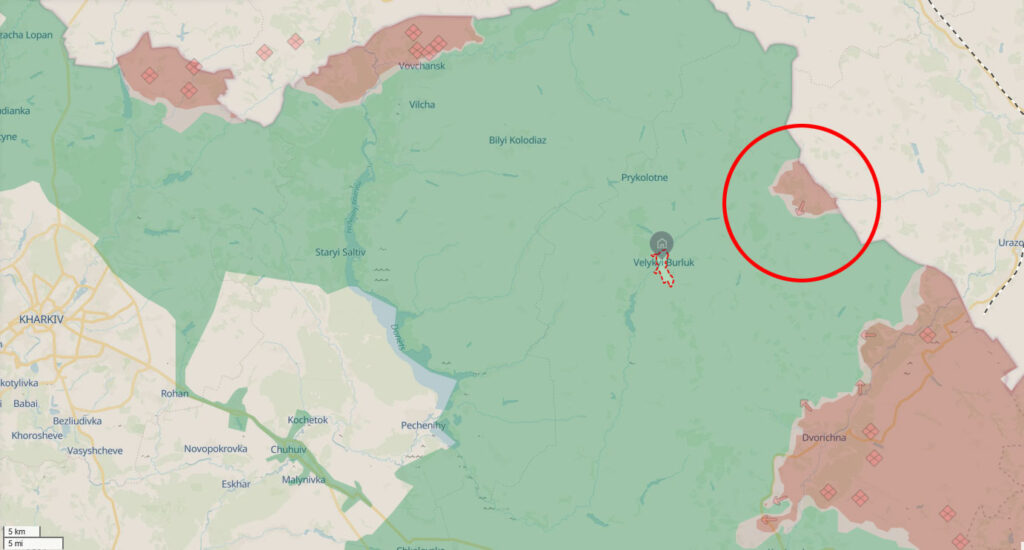
Ukrainian forces confirmed that a russian colonel killed in Kharkiv fighting was taken out while directing attacks near the border. The Operative-Strategic Group of Forces Khortytsia, a Ukrainian military command on the eastern front, said Col. Lebedev, commander of the 83rd motorized rifle regiment of the 69th motorized rifle division, died as he tried to push assaults forward in the Velykyi Burluk direction.
The Ukrainian command reported late on 26 July that defenders destroyed the officer who had led storming operations aimed at widening Russia’s small foothold west of the Kupiansk front. The command’s report mentions only the last name of the eliminated colonel, Lebedev.
Earlier, Oleksii Rozumnyi from the 13th brigade of the National Guard unit Hartiia said Russian forces are using these border attacks to pull Ukrainian reserves into the area. According to him, the occupiers have shifted tactics since the time of the Kursk offensive. They now focus more on logistics strikes and use drones equipped with fiber optics to hit deep, sometimes almost reaching Kharkiv city.
Reports also describe heavy clashes east of Vovchansk — a border town further west of Velykyi Burluk, where Russian troops have tried to break through Ukrainian defenses and move in the direction of Velykyi Burluk.

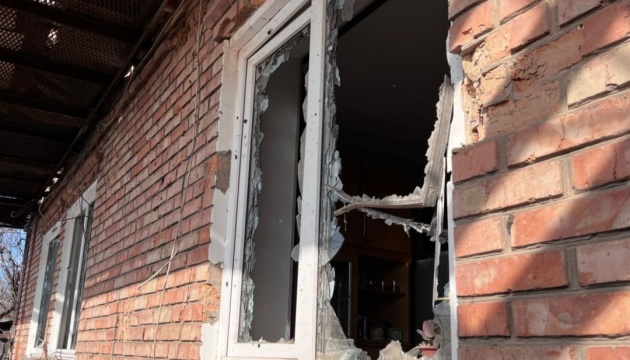
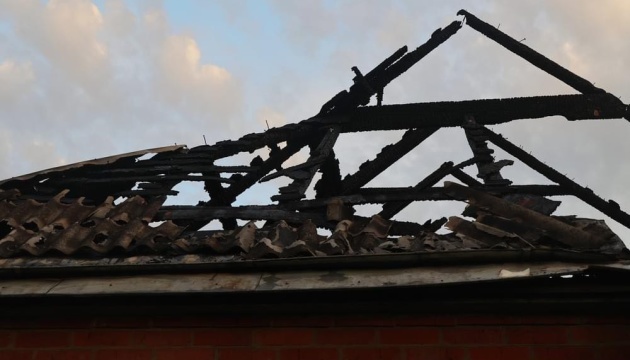
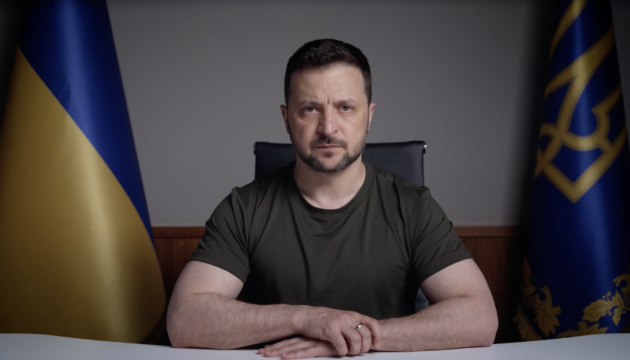
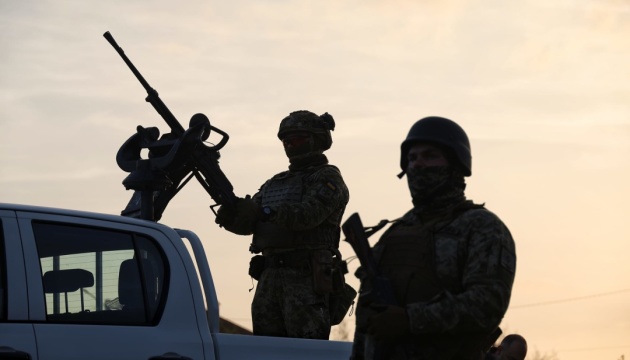
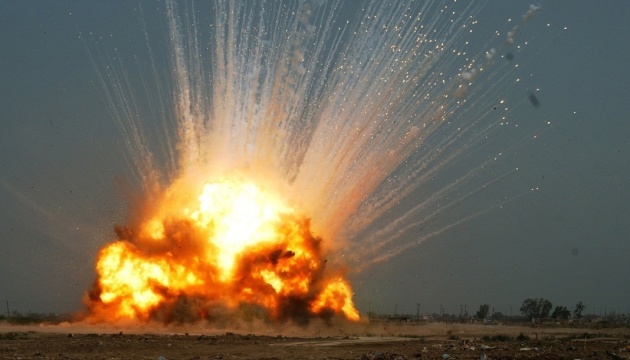
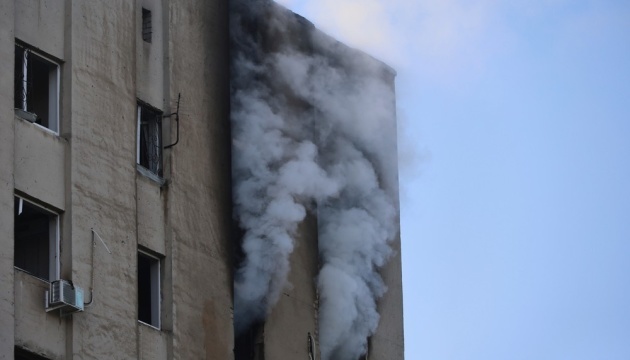

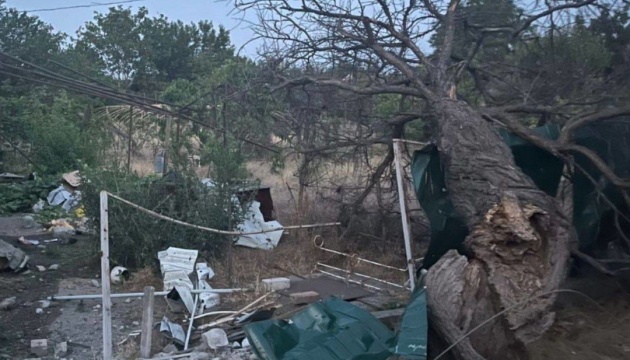
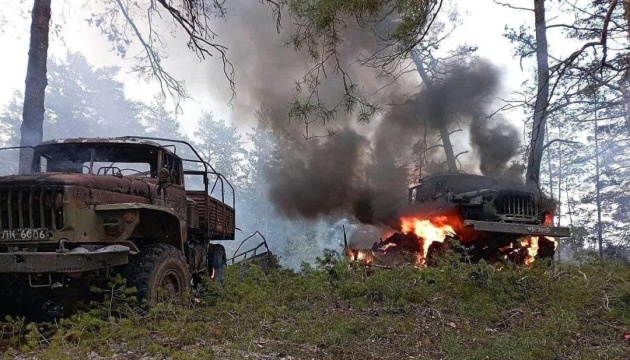

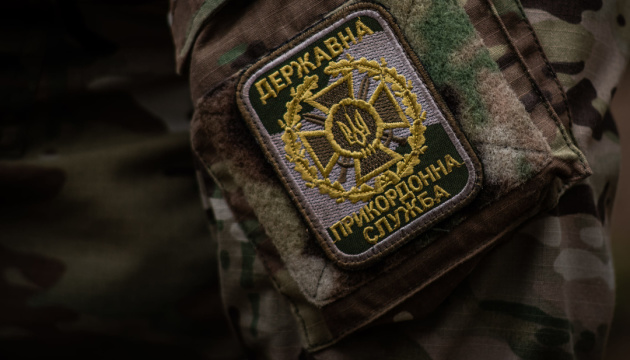

Ukraine receives Patriot air defense systems, and it’s just the beginning. The US and its allies have provided the systems under a new scheme in which European nations foot the bill for American weapons supplied to Kyiv, The Washington Post reports.
US-made Patriot air defense systems are the only weapons in Ukraine that are capable of intercepting Russian ballistic missiles.
Germany has already delivered three Patriots. One more is under discussion with the US, while Berlin has pledged to help provide a total of five.
Defense Minister Boris Pistorius has confirmed this during a meeting of Ukraine’s allies, without going into further detail.
In the first half of 2025, 6,754 civilians in Ukraine were killed or injured, the highest number for a six-month period since 2022, the UN reports. In July alone, Russia launched at least 5,183 long-range munitions at Ukraine, including a record 728 drones on 9 July. Kyiv, Dnipro, Kharkiv, and the port city of Odesa have been hit hardest in recent weeks.
Kyiv is aiming to receive ten Patriots under the new arrangement. Some batteries could even come from outside NATO. For instance, Switzerland has agreed to redirect five systems it had previously ordered to Ukraine, and will receive its own later.
Under the new scheme, Ukraine will also receive advanced radars, electronic warfare systems, drone interceptors, and artillery platforms, according to two informed officials.
Meanwhile, the issue of long-range weapons remains unresolved. Germany has already ruled out supplying Taurus cruise missiles. The US has not provided a clear signal. NATO officials are not ready to confirm that such transfers will not happen in the future, despite US President Donald Trump’s refusal.

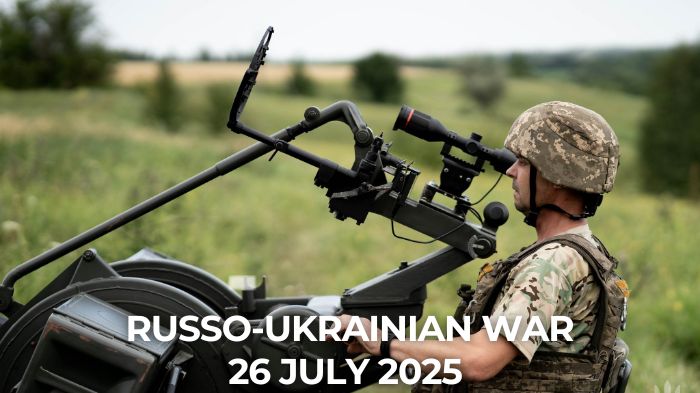
 |
Ukrainian Gen Zs just did what the Russian opposition never could. Cardboard signs, three days, one very surprised president. |
 |
Russia’s last tank yards go dark as every inch in Ukraine demands more sacrifice. Russian workers are pulling the last Soviet tanks from storage yards that used to hold hundreds. The math is unsustainable. |
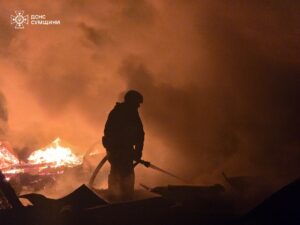 |
Russia built Ukraine’s drone storm over three years — 2025 is when it finally breaks. Russia’s drone war Ukraine’s allies thought they understood is about to change entirely — and Europe is not ready for what breaks loose in 2025. |
 |
Vacancies: News reporter, Defense tech reporter, Head of SMM. Euromaidan Press is expanding and searching for professional soulmates who believe in independent journalism. |
Russia cancels main naval parade after losing 33% of Black Sea Fleet in Ukrainian drone strikes. The Russian leadership may be afraid the event will showcase its vulnerability.
Ukraine’s Intelligence: Russian jet used to train war pilots suddenly bursts into flames in Krasnodar Krai. A Su-27UB catches fire deep inside Russia as Ukraine shows it can hit before the missiles are even in the sky.
Ukrainian drones reportedly hit Russian military electronics plant under international sanctions in Stavropol. Two precision strikes hit critical production areas at Russia’s Signal plant, destroying numerical control machinery and radio electronics workshops that supply equipment to the Russian military-industrial complex
BBC: At least 245 18-year-old Russians killed in war against Ukraine since April 2023
. Vladimir Putin’s assurance that no 18-year-olds would fight in Ukraine has been contradicted by a BBC investigation documenting 245 deaths of teenage contract soldiers since Russia eased enlistment rules in April 2023.
Musk orders Starlink shutdown near Kherson in 2022 to thwart Ukrainian army’s counteroffensive – Reuters. Elon Musk’s shutdown order, driven by fears of nuclear escalation, left Ukrainian troops without communications and blinded their drones during the September 2022 Kherson counteroffensive.
“Moscow mechanism” will now investigate Russia’s killings of Ukrainian POWs at request of 41 nations. Over 90% of returned Ukrainian prisoners report systematic beatings and torture.
Poll reveals 14% of Slovaks want to join Russia
. While 32.5% reject military neutrality if it harms living standards, 15% embrace it unconditionally.
EU withholds nearly €1.5 billion package for Ukraine due to failures in anti-corruption justice. After delays in judicial and governance reforms, Ukraine secures only part of the latest EU payment.
Frontline report: Russia’s oil smugglers are running out of ocean as UK freezes 100+ shadow fleet tankers. Insurance firms, legal services, and port facilities across Europe are now off-limits to any vessel connected to Russia’s price cap violations, forcing tankers into increasingly circuitous routes to avoid detection.
EU lawmakers push gas ban deadline forward as Russia loses energy grip on Europe. Members of the European Parliament want to cut Russian gas imports by January 2027 instead of 2028, claiming that Moscow’s pipeline influence continues to shrink from 45% to 19% since 2022.
German AfD moves to expel young politician who fought Russians in Ukraine. A 22-year-old German politician who secretly served in Ukraine’s army now faces expulsion from the pro-Russian Alternative for Germany party after calling his own leadership “Russia-kissers.”
Orban: Ukraine EU membership would “drag war into Europe,” proposes buffer state role instead
. Hungary’s Viktor Orban rejected Ukraine’s European Union membership bid 25 July, instead proposing “strategic cooperation” while describing Kyiv as destined to remain a “buffer state” bordering Russia
Zelenskyy vows swift retaliation after Russia’s night of civilian bloodshed. Russian missiles tore through homes and shops, killing civilians in Dnipro and pounding Kharkiv for three relentless hours.
Massive combined attack on Ukraine kills three people, injures 15 other. Russian forces deployed 235 air assets overnight, of which Ukraine intercepted 200.
Ukraine’s anti-corruption agencies suddenly close four long-stalled cases in one week following prosecutor general’s takeover. Following President Zelenskyy’s signature on the law, the anti-corruption agency finalizes the massive $225 million PrivatBank embezzlement case.
Read our earlier daily review here.
You could close this page. Or you could join our community and help us produce more materials like this.
We keep our reporting open and accessible to everyone because we believe in the power of free information. This is why our small, cost-effective team depends on the support of readers like you to bring deliver timely news, quality analysis, and on-the-ground reports about Russia's war against Ukraine and Ukraine's struggle to build a democratic society.
Become a patron or see other ways to support.
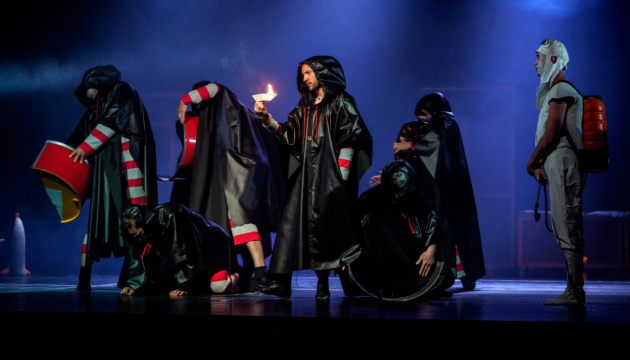
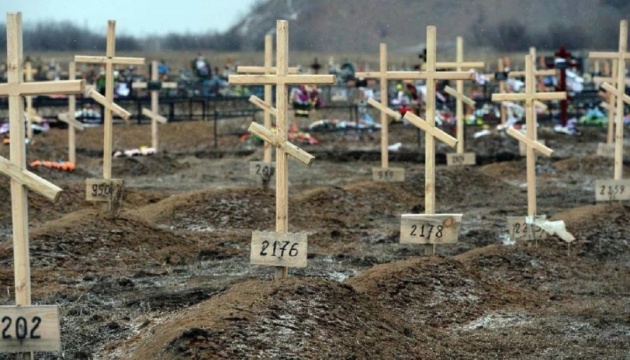
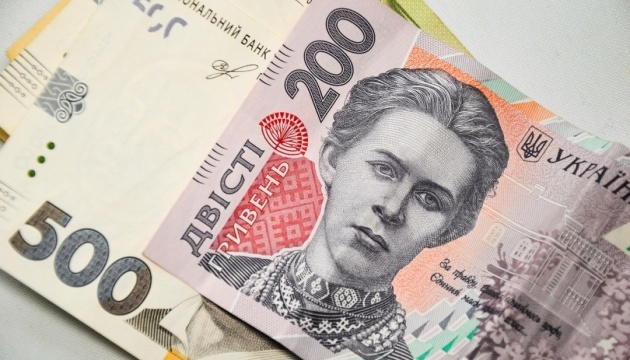

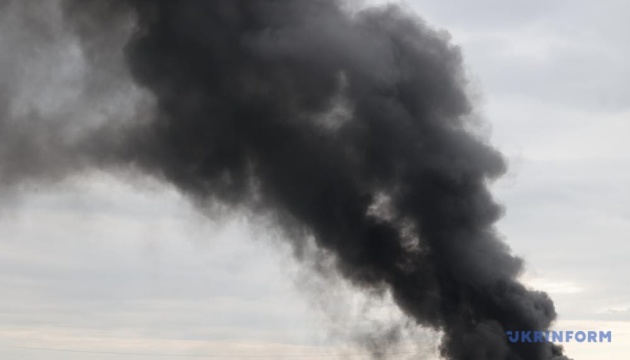


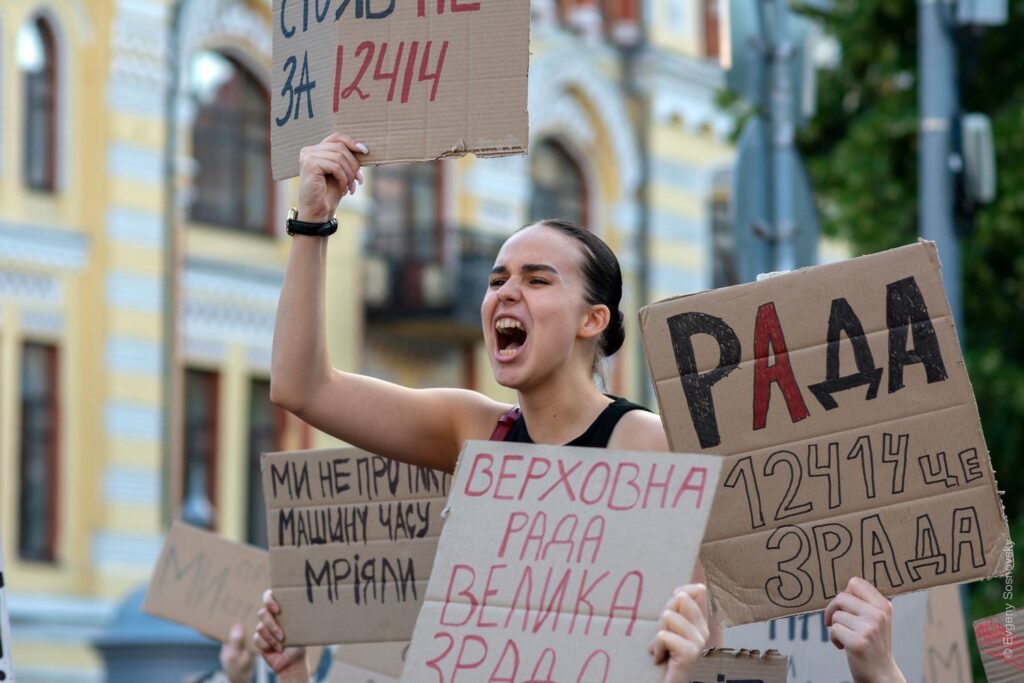
“Fucked up reformers!” screamed the sign of 18-year-old Polina, the girl with the green hair. Her companion’s metaphorically shouted “CUNTS” in huge green letters. Teenage profanity filled every corner of the first large wartime protests engulfing Ukraine’s capital.
It could have been any Gen Z rebellion against the system. And in a way, it was—against a system where President Zelenskyy gutted Ukraine’s anti-corruption bodies over just 72 hours. Except it was also a protest for a system—the one Ukraine dreamed up during the Euromaidan revolution in 2014.
“I don’t give a f*ck,” Polina snapped back at criticism over the protests’ expletive language. “Swearing allows you to express an opinion and is part of the freedom of speech. Get it?”
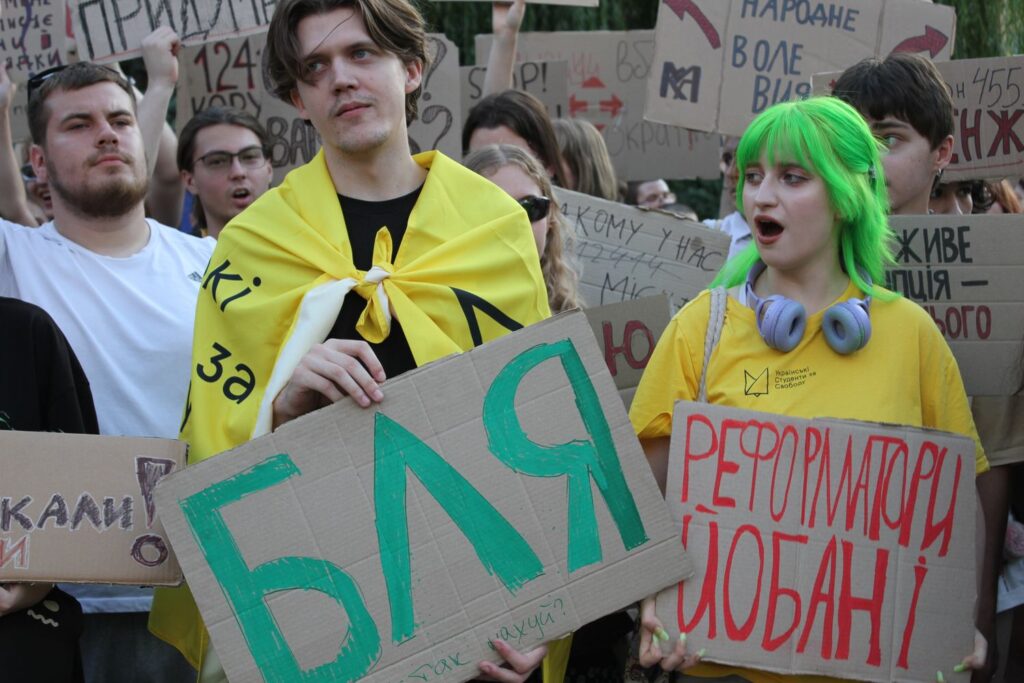
Prudes on Facebook scolded protesters like her: it was beneath Ukrainian national dignity to devolve to such unholy vocabulary.
Yet there she was, a first-year student of Ukraine’s top university, one uncle killed during the 2014 protests where Ukrainians rebelled against a pro-Russian president’s U-turn on EU integration, and another uncle killed fighting the Russian invasion, unapologetically demanding political accountability from Ukraine’s president.
“We know our history, we know why this happened. We are fighting for our freedom from Russia. We are against Ukraine turning into Russia from the inside. So, NABU should be an independent institution,” she said.
Polina encapsulated the main demand of the protests—that a law to bring Ukraine’s anti-graft agencies under the control of a presidentially appointed prosecutor is repealed.
Tens of thousands of people like Polina, holding a sea of cardboard signs, may have just saved Ukraine’s democracy.
Protesters against corruption in Kyiv. Photo: Evgeny Sosnovsky
Twenty-three-year-old Zinaida Averina never expected to become the architect of Ukraine’s first wartime democratic uprising. When parliament rushed through legislation gutting anti-corruption agencies on 22 July, she created a Telegram chat for protesters that exploded to over 2,000 people within hours.
“The only person who filed an application with Kyiv city administration for the 23 July protest was my friend Sofi Wisdom, also 23,” posted activist Anastasiia Bezpalko. “None of the organizations or opinion leaders who called for protests did this basic work. The girls showed leadership in a crisis and took enormous responsibility.”
The chat became a masterclass in grassroots democracy. Participants debated protest demands, coordinated with police, organized snacks and water stations, and—uniquely for a political movement—created separate threads for memes and hookups. “What could be sexier than a clear civic position?” joked one organizer. “We need to solve the demographic crisis!”
Many signs cheekily declared “This cardboard is paid for”—a stab at conspiracy theories claiming Western funding behind the protests’ eruption.
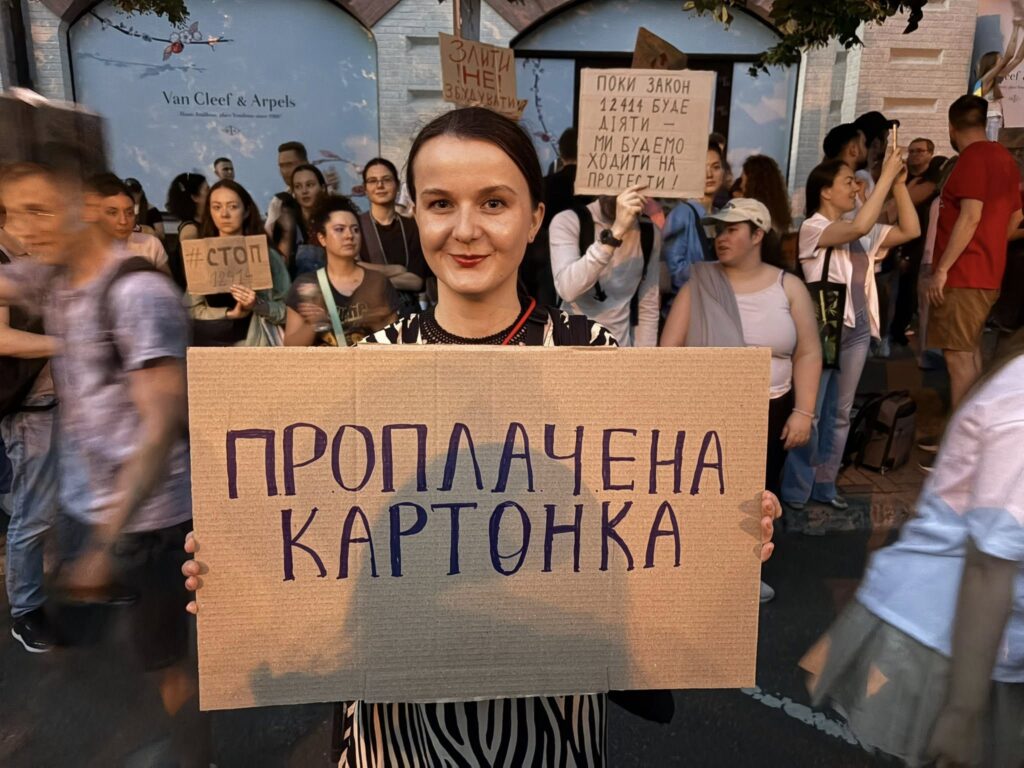
But the most remarkable thing happened on the streets. “Two very young people, eyes shining with excitement, look at the crowd,” witnessed Anton Senenko. “Katia, this is our first Maidan!” one exclaimed, invoking Kyiv’s Independence Square, Maidan Nezalezhnosti, where all the revolutions happen.
They kissed.
Not exactly your typical protest energy. But then again, this wasn’t your typical protest.

Critics fixated on the protesters’ colorful language, missing why it was so politically effective. Oleksandr Rachev explained the strategy behind the swearing.
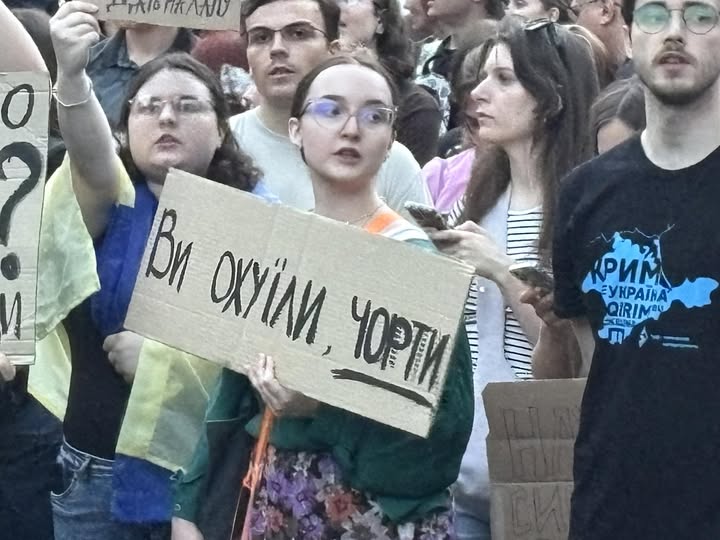
“When you tell authorities ‘you’re wrong,’ you stay within a model of respect that doesn’t frighten them,” he noted. “When you say ‘you’ve lost your fucking minds,’ it means questioning their very legitimacy. And that scares them.”
The profanity served another function: mass appeal. “Swearing is considered the language of ‘ordinary people,'” Ravchev continued. “University professors and activists don’t swear—that’s why they stay in their intellectual bubble. Swearing is a bridge between creative youth protesting and ordinary voters who actually vote.”
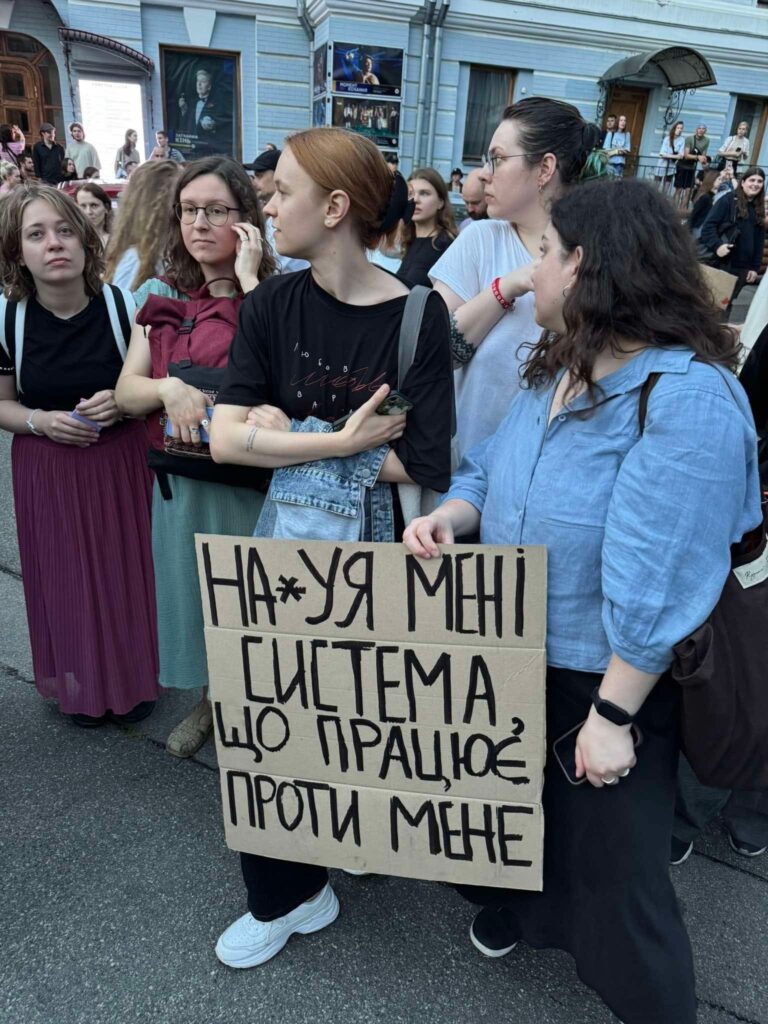
The slogan “I need a system that works for me” would be fine for intellectuals, he argued. But “Why the fuck do I need a system that works against me?” reaches ordinary people’s minds. “Because that’s exactly how they talk.”
Behind those Facebook posts scolding protesters about “pure language,” Ravchev detected real fear: “The authorities are terrified that profane protest slogans will reach mass voters and sweep them away.”
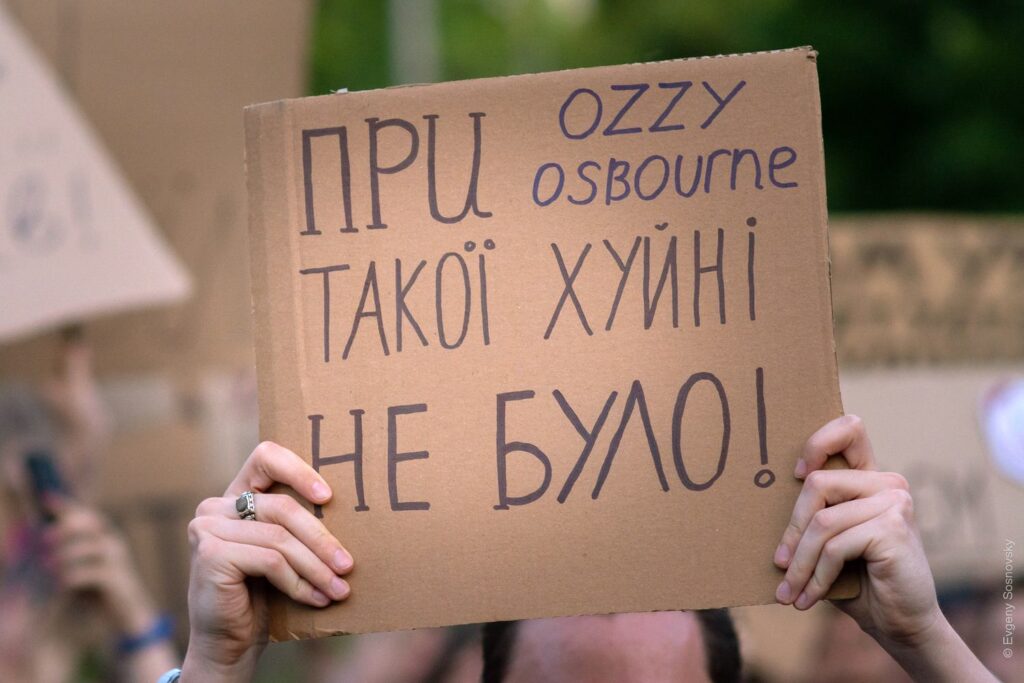
Academic Volodymyr Kulyk found himself shouting “The Office fucked up” despite never swearing in front of his wife in 35 years. The moment surprised him—but he understood what was happening.
The youth had “finally desacralized power, which can now be addressed without picking words, at least when it deserves it,” he wrote. When even a polite academic starts cursing at the government, something fundamental has shifted.
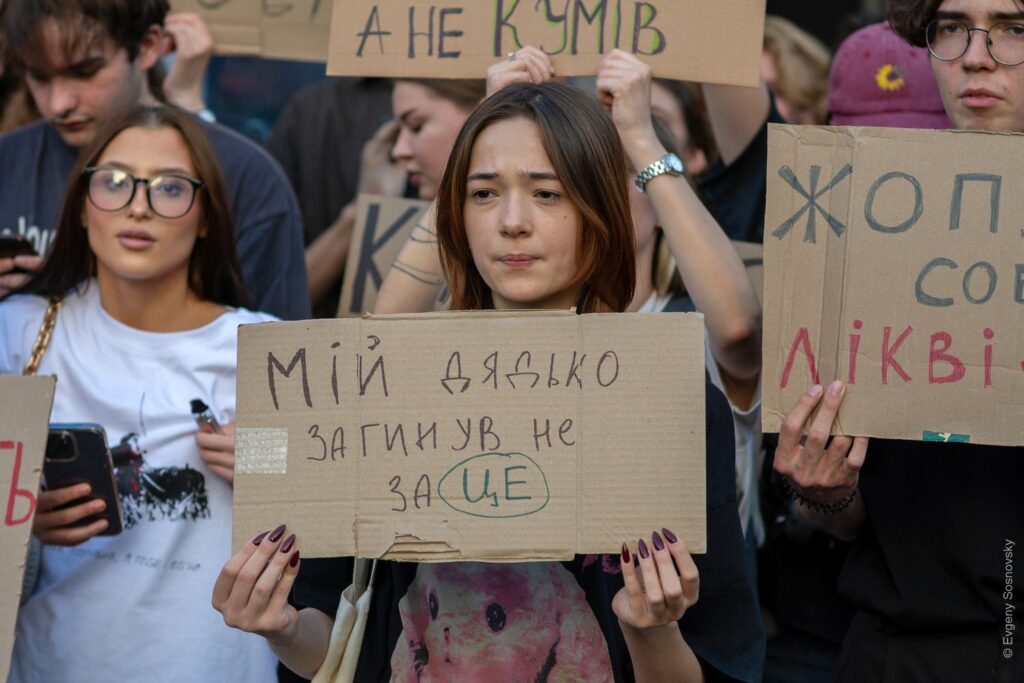
But there was a deeper reason behind the raw language. These weren’t typical teenagers. Tetiana Troshchynska noted: “My hairdresser tells me about all the gray children she gives haircuts to. 12, 13, 16 years old. Half-gray heads, gray streaks, gray like salt. I tell some, not others, because they’re sad and crying. I don’t know where they’re from, what they’ve experienced, who they’ve lost.”
The Kapranov Brothers added: “Swearing is a consequence of war, exactly like ruins, minefields and trenches. Just as we’ll have to demine forests and seas from Russian mines after the war, we’ll have to demine heads from swearing. But—after the war.”
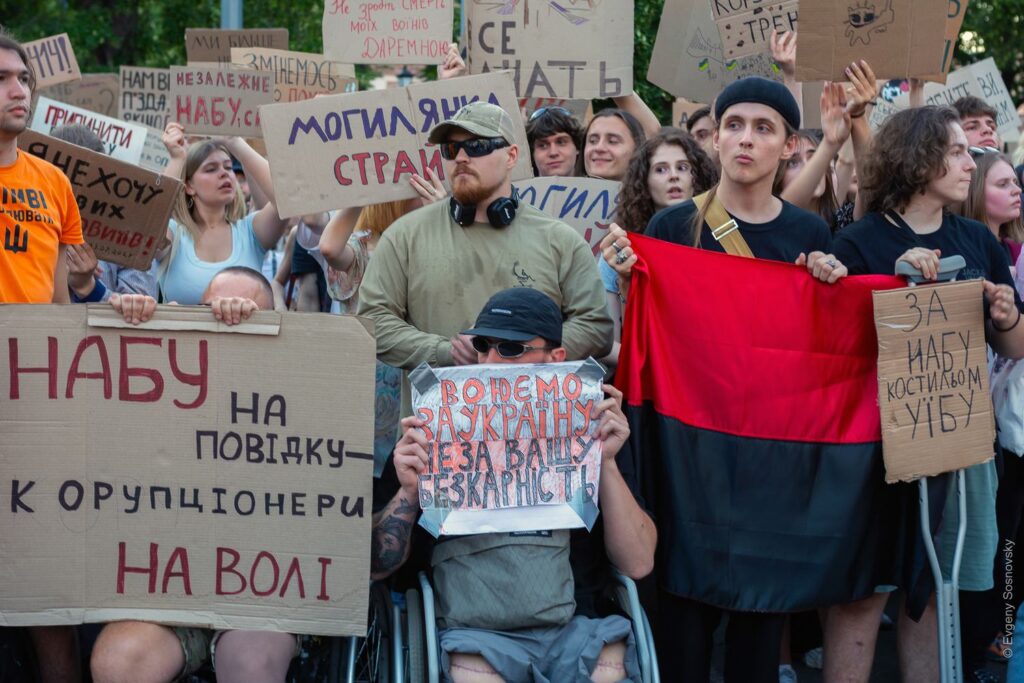
These weren’t kids who idealized the two anti-corruption agencies, NABU (National Anti-Corruption Bureau) and SAPO (Special Anti-Corruption Prosecutor’s Office). Most protesters readily admitted both agencies had problems—corruption scandals, slow investigations, bureaucratic failures.
But they grasped something critics missed: the choice wasn’t between perfect institutions and flawed ones. It was between flawed institutions and no independent oversight at all.
“They’re trying to get rid of essentially the only anti-corruption mechanism that Ukraine has,” Marco, a 25-year-old who lived in Chicago for a decade before returning to Kyiv, explained to Euromaidan Press. “By doing that, they’re trying to integrate it into the actual government, which makes it so the people in government who are corrupt decide whether they themselves are corrupt, right? So, it’s a little counterintuitive.”
NABU and SAPO, whatever their flaws, were the first real separation of power in Ukraine—bringing it closer to a functioning democracy and further from the likes of the autocracies in Russia and Belarus.
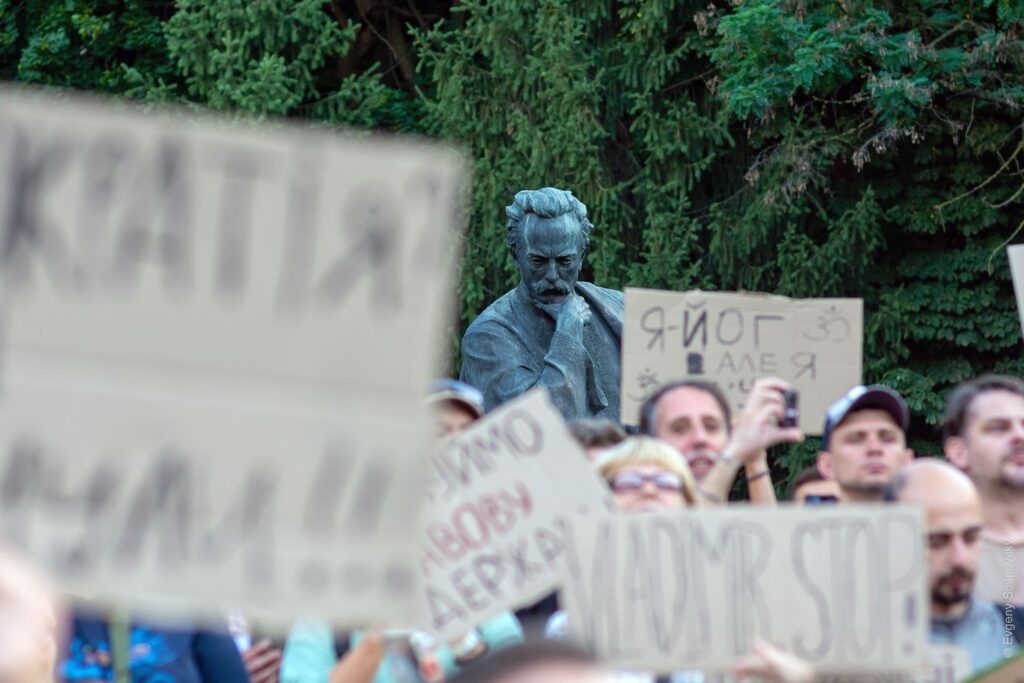
But focusing on the swearing missed the real cultural phenomenon. Most signs weren’t profane—they were poetic.
Ukrainian cultural observer Olena Chervinik noted that these cardboard creations represented “real poetry, with all its nerve and broken form. Something in the tradition of Ukrainian futurists—short, with broken lines, unconventional syllable division.”
Signs mixed Latin script with Cyrillic, quoted Taras Shevchenko alongside modern poets, featured portraits of Lesya Ukrainka next to Zelensky caricatures.
“If you want to know where modern poetry is in Ukraine—here it is, on these cardboards,” one literary critic observed. “Poetry as a weapon is something very Ukrainian.”
This was Ukraine’s first Twitter-era protest movement; the cardboard sea of short, punchy statements was tweets gone offline.
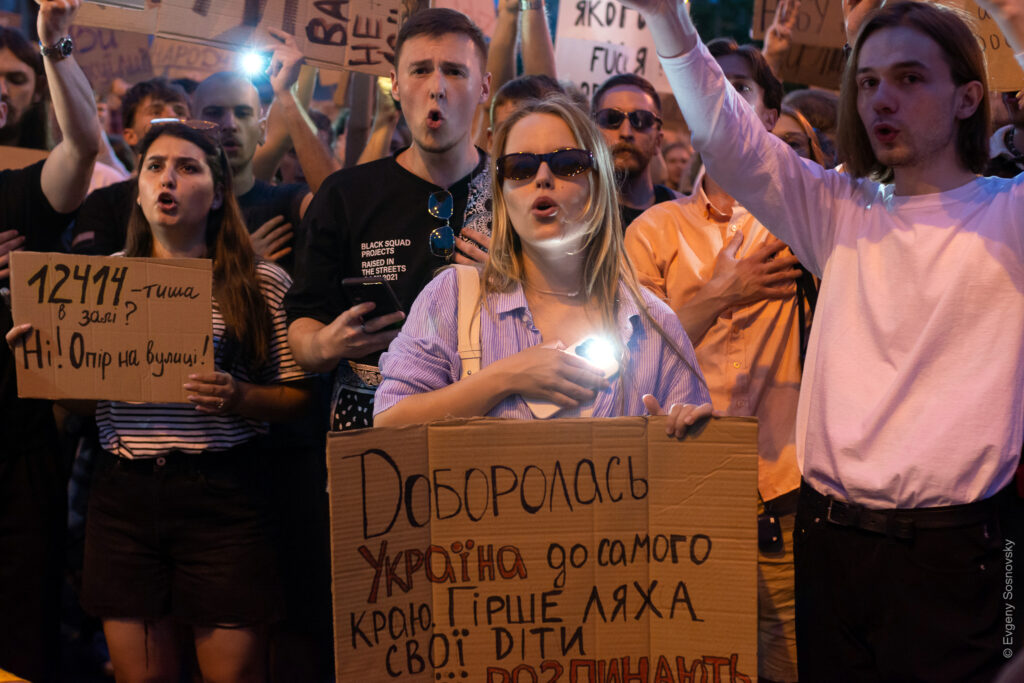
Yet paradoxically, it produced some of the most sophisticated political poetry seen on Ukrainian streets:
“I demand 263 explanations,” says one protester, invoking the 263 MPs who voted for the law, amid a sea of Gen Z’s cardboard signs right at the backyard of the President’s Office in Kyiv. Photo: Evgeny Sosnovsky
The protests revealed something deeper than anger over specific legislation. As wounded veteran and protester Sabir explained: “We had an unspoken social contract: we don’t criticize the authorities during war, but they don’t pull any bullshit. But they kept pulling bullshit. Now they decided they could allow themselves more. People showed they couldn’t.”
The speed of the legislation shocked even seasoned political observers. Bills typically languish in parliament for months. This one passed in hours, with Zelensky signing it the same evening as protests erupted outside his office.
“When you pass such a law in one evening, it looks very much like fear of losing power,” said IT worker Olena Danyliuk, 31. “They’re trembling at the thought they might have to give up power.”
EU officials were reportedly shocked when they learned of the legislation. Brussels had planned to secretly fast-track Ukraine’s accession talks, but the anti-corruption law threatened that timeline.
Perhaps Ukraine was following Georgia’s trajectory—offering high hopes but ultimately succumbing to pro-Russian authoritarianism?
Not so fast, said the youngsters with their “silly” signs.
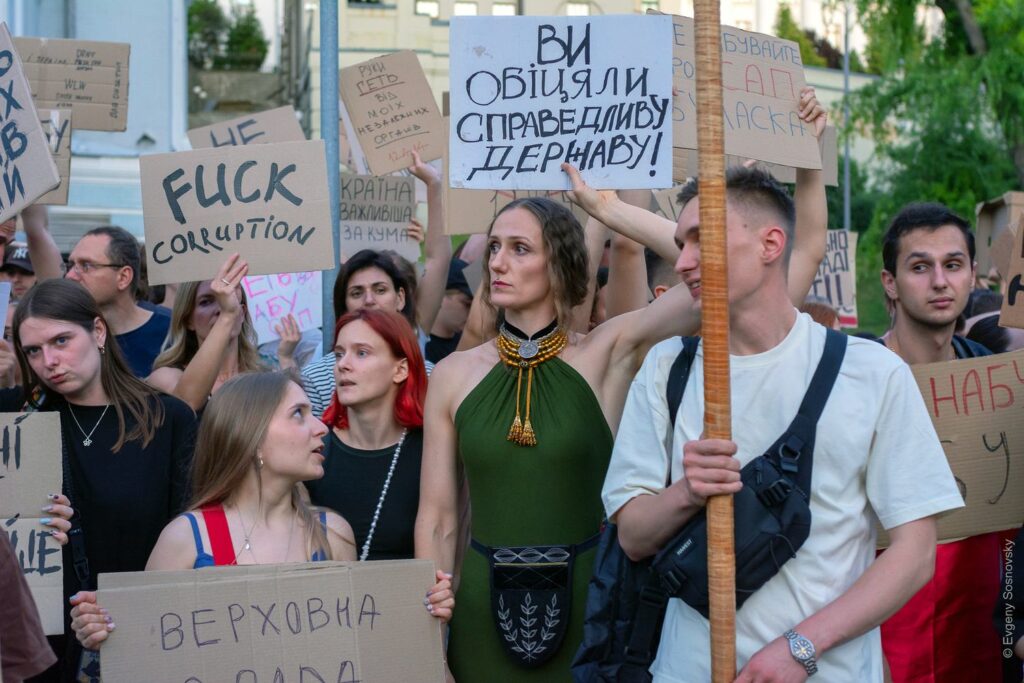
The contrast with Western youth movements couldn’t be more vivid. While American and European teenagers often target democratic institutions themselves—demanding to tear down systems they see as irredeemably corrupt—Ukrainian Gen Z fight to preserve and strengthen democratic institutions against authoritarian capture.
This difference reveals an ironic truth: Western youth don’t know how good they have it. They’ve never lived without independent courts, free press, or anti-corruption agencies. They can afford to attack these institutions because they’ve never experienced their absence.
Ukrainian twenty-somethings have gray hair at 16 and dead relatives in their family trees. They know exactly what happens when democratic institutions disappear. They are, actually, dying for a stab at a democratic future, not the one that Russia offers—where opposition figures end up dead or imprisoned, where corruption flows unchecked because there’s no independent oversight.
As veteran protester Ivan Chyhyryn, who lost his leg rescuing a wounded comrade, told reporters: “My parents were on Maidan in 2014 when I was very young. Creating independent anti-corruption institutions was one of their goals. What my parents fought for is now being thrown away.”
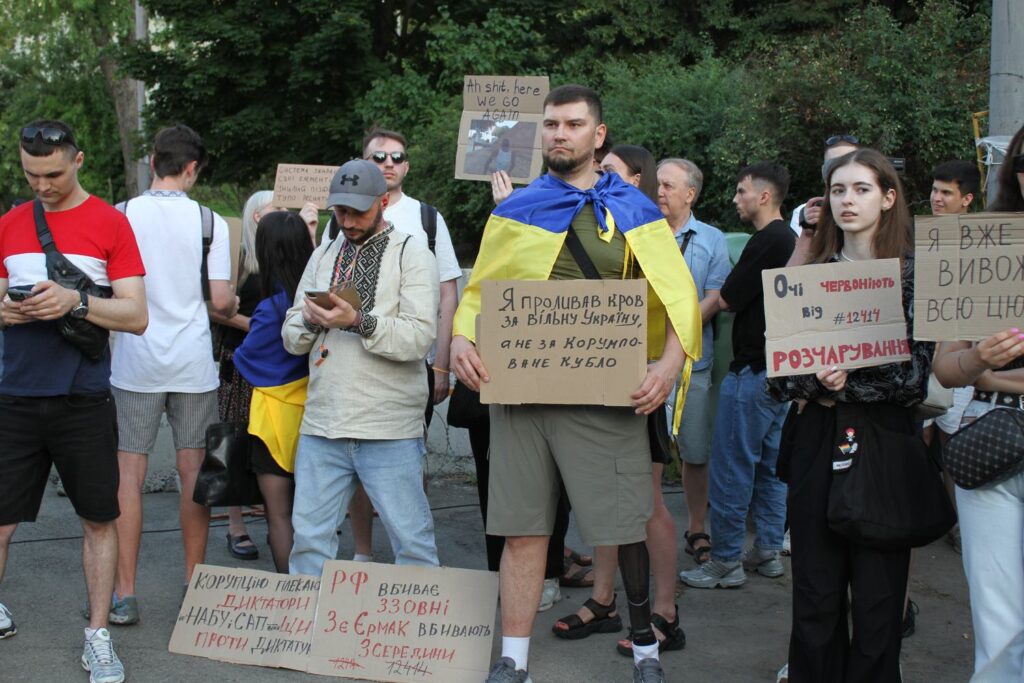
His generation inherited revolution in their DNA—the Orange Revolution in 2004, the Revolution of Dignity in 2014, and now resistance to democratic backsliding in 2025. But unlike previous generations who had to build democracy from scratch, these youth were defending institutions they’d grown up with.
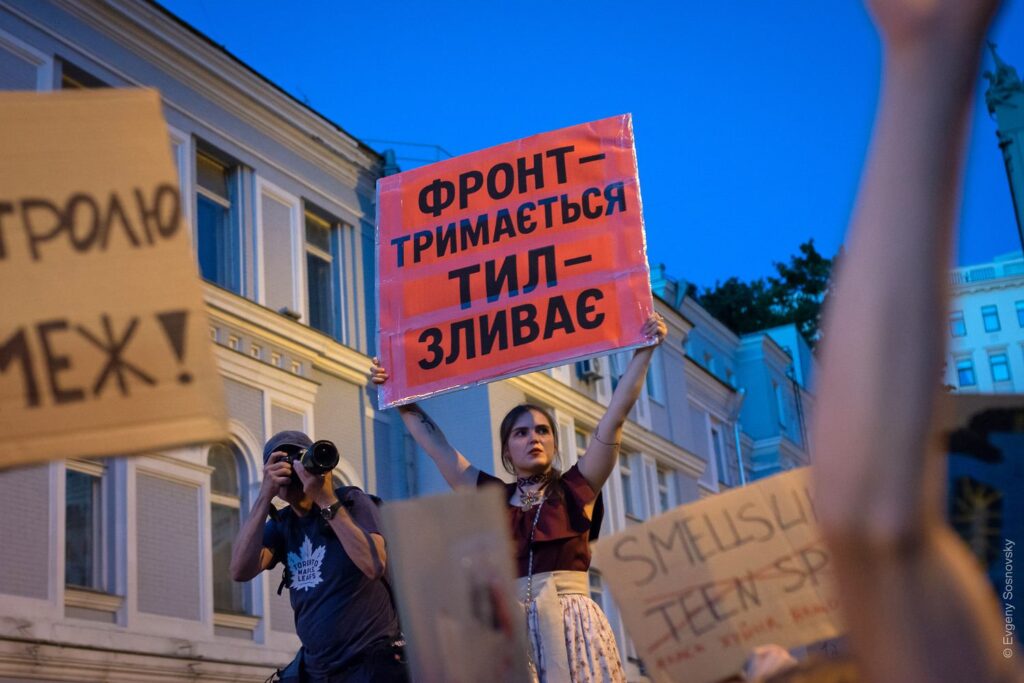
By Wednesday evening, Zelensky announced he would submit new legislation preserving anti-corruption agencies’ independence. “We heard the street,” he said—the same president who’d ignored international criticism and parliamentary opposition.
And this illustrated the main difference between Ukraine and Russia: Russian opposition complains it can’t change anything while Ukrainian teenagers flood the streets with “Fuck corruption” signs and win.
“I genuinely believe that if this happened in Russia, police would have just come in and beat everybody up,” Marco told Euromaidan Press. “In Ukraine, though, we really are freedom-loving and we will show the government that we are the ones in charge, not them.”
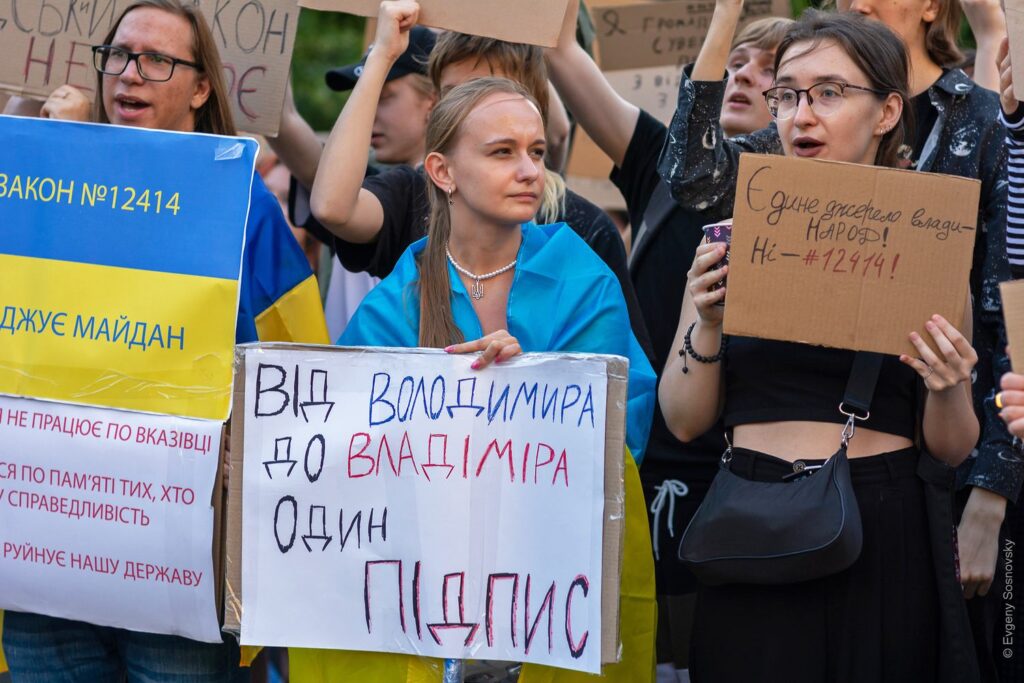
Even Russian independent media called these protests a “political crisis.” For Russians, street demonstrations represent a system breakdown. For Ukrainians, they represent the system working—checks and balances moving from the streets into the political fabric.
As protester Polina put it: “Only we can fight for our best future. That’s why we’re all here.”
Not bad for a generation whose main political tools are Twitter, Telegram, and magic markers.
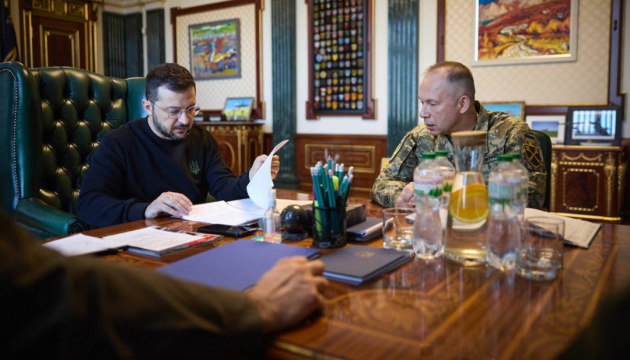
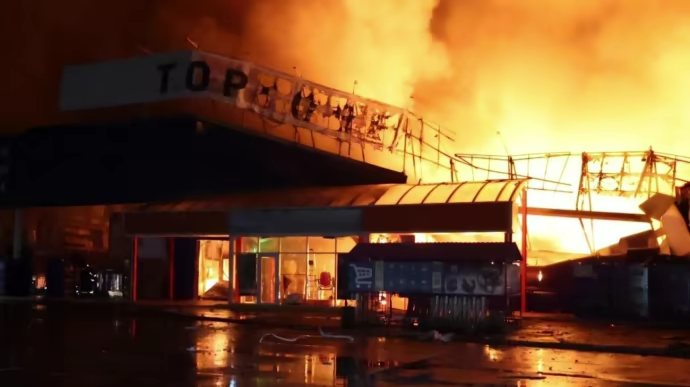
Ukraine’s response to recent Russian attacks on civilian cities will be swift. On 26 July, President Volodymyr Zelenskyy said the enemy will inevitably feel the consequences of their actions.
On the night of 26 July, Russian forces launched drones and missiles. Dnipropetrovsk, Kharkiv, and Sumy oblasts came under fire. Three people were killed in Dnipro, and six more were injured. Kharkiv endured three hours of relentless assault. The Russians used missiles, including ballistic ones, as well as attack drones.
The Ukrainian president stated that Russia will face retaliation for the killings.
Russia does not intend to end its war against Ukraine. On the contrary, Russian ruler Vladimir Putin has told US President Donald Trump that military actions will escalate during the summer offensive. In the first half of 2025, Russia killed or injured 6,754 civilians in Ukraine, the highest number for a six-month period since 2022.
“There are wounded as a result of the Russian strike. Unfortunately, there are also casualties. My condolences,” he wrote on Telegram.
He also emphasized: the response will be precise and daily.
“Russian military enterprises, Russian logistics, and Russian airports must feel that their own war has real consequences for them. The accuracy of our drones and the daily nature of Ukraine’s responses are among the arguments that will definitely bring peace closer,” Zelenskyy said.
Russia’s Defense Ministry justified the attack by claiming it targeted Ukrainian defense enterprises. In reality, the missiles hit residential buildings and an electronics repair store.
“The objective of the strike was achieved,” it reported.
Earlier, the Ukrainian Defense Intelligence said that a Su-27UB combat training jet caught fire overnight on 26 July in Russia. The incident happened at the Armavir airfield in Russia’s Krasnodar Krai, which lies more than 850 km from the Ukrainian border.
Ukraine’s Intelligence: Russian jet used to train war pilots suddenly bursts into flames in Krasnodar Krai
It is intended for training pilots for the war against Ukraine, while retaining the combat capabilities of the base aircraft: speeds of up to 2,500 km/h.
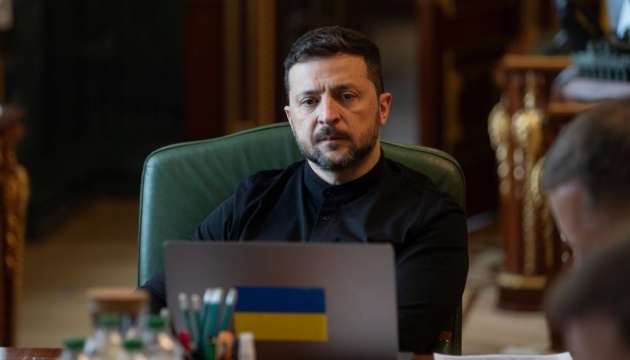

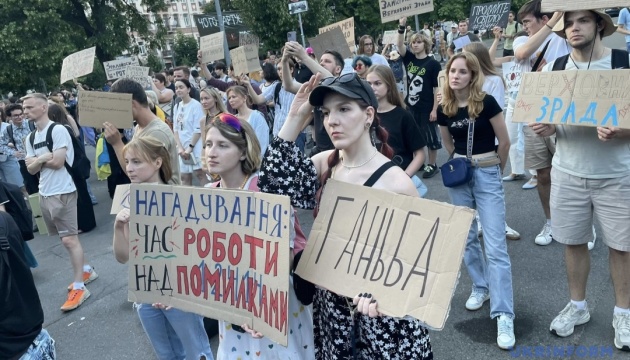
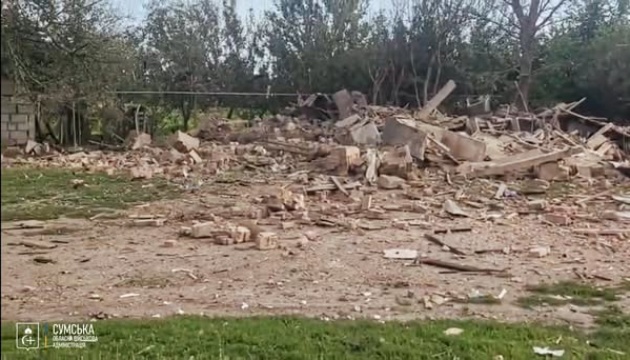



Russia has canceled its main naval parade of the year. Saint Petersburg has suspended the event scheduled for 27 July 27 in Saint Petersburg, the Center for Countering Disinformation under Ukraine’s National Security and Defense Council reports.
Since 2022, Ukraine has destroyed approximately 33% of the combat ships of Russia’s Black Sea Fleet. This includes about 24 ships. The most painful loss was the sinking ofthe cruiser Moskva, the flagship of the Russian fleet. In 2022, it struck Ukraine’s Zmiinyi (Snake) Island after Ukrainian border guards refused to surrender, famously declaring: “Russian warship, go f*** yourself!”
Due to the cancellation, the traditional passage of ships along the Neva River will not take place, and the salute from the Peter and Paul Fortress will remain a memory this year.
The Center for Countering Disinformation claims, “The Kremlin can no longer pretend that the war does not affect the Russian rear. The war impacts all spheres of life in Russia, even symbolic and loud events like the naval parade.”
The parade cancellation may be linked to the military leadership’s fears due to real losses suffered by the fleet. An event meant to demonstrate Russia’s power now risks having the opposite effect, causing discouragement and fear.
Against this backdrop, the decision to scrap and send Russia’s only aircraft carrier, Admiral Kuznetsov, to the scrapyard is particularly telling, further highlighting the problems of the Russian fleet.

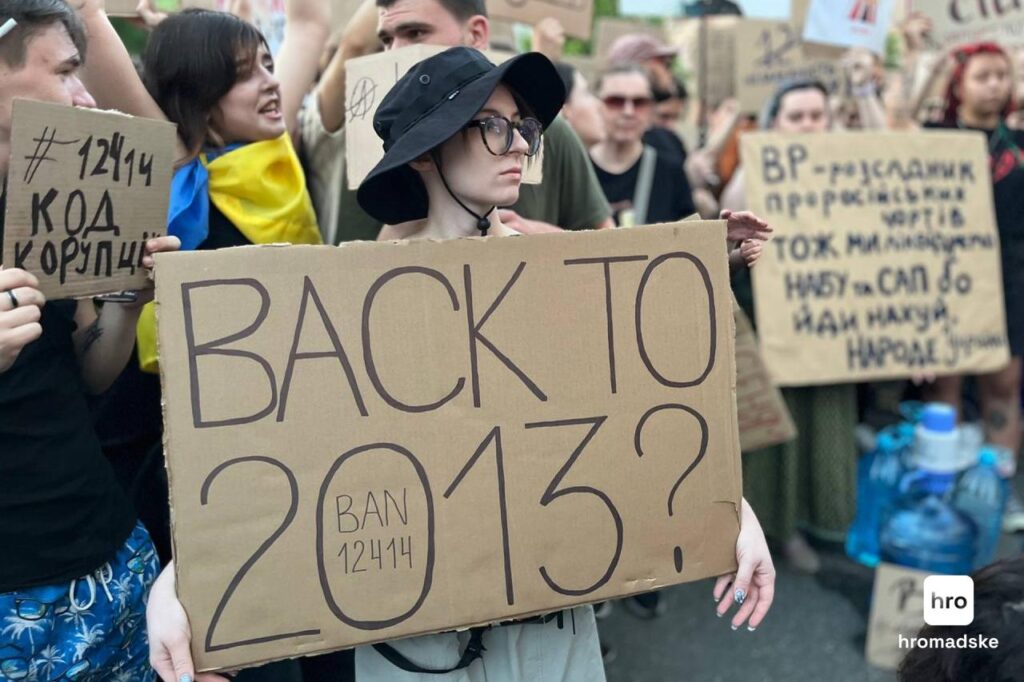
After a law limiting the independence of anti-corruption bodies came into effect, one of them, the National Anti-Corruption Bureau or NABU, announced the completion of investigations of long-term cases. Four high-profile criminal cases were closed in one week by the agency, Glavkom reports.
President Volodymyr Zelenskyy signed the law, curtailing the independence of NABU and the Specialized Anti-Corruption Prosecutor’s Office (SAPO) on 22 July. It requires key decisions by these institutions to be coordinated with the Prosecutor General’s Office.
This surge in anti-corruption activity coincided with a public statement by the new Prosecutor General, Ruslan Kravchenko, about his intention to intervene in certain cases that NABU had been investigating for years.
“In such cases, I will raise questions and possibly create a joint investigative group with other employees,” said Kravchenko.
For comparison: in January 2025, NABU did not report about the number of cases brought to a conclusion. According to the Center for Countering Corruption, the agency completed one in May and three in March, Texty reported.
Finally, NABU completed the investigation of one of the largest cases involving the embezzlement of over $225 million from PrivatBank before its nationalization. According to the investigation, the money was funneled through a scheme of fictitious loans registered to controlled entities.
The case involves six suspects, including oligarch Ihor Kolomoisky, who has been in custody since 2023.
Pavlo Kyrylenko, head of the Antimonopoly Committee, is charged with failing to declare significant property, including several apartments in Kyiv and Uzhhorod, a residential house of over 220 sq.m. near Kyiv, two land plots, two garage boxes, six parking spaces, three non-residential premises totaling over 190 sq.m., and a BMW X3 car. Additionally, a separate case regarding Kyrylenko’s alleged illegal enrichment amounting to over $1.75 million is under review and has already been transferred to the High Anti-Corruption Court.
Regional judges systematically issued fake rulings allowing men to avoid mobilization. The most common reason was the status of “sole parent.” According to the investigation, $3,500 was charged for such rulings. A total of 1,040 similar rulings were issued over the past year.
Another case was completed, and this time against an SBU officer who, according to the investigation, demanded $300,000 for destroying materials related to the illegal smuggling of men abroad. If refused, he threatened to initiate criminal prosecution under more serious charges.
